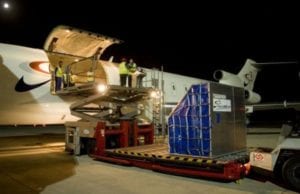The International Air Transport Association (IATA) has released data for global air freight markets showing very modest growth in September.
Measured in Freight Tonne Kilometers, air cargo volumes rose 1.0% compared to the same month a year ago. This is a slight improvement on the August performance when volumes were broadly stable. Overall, however, air cargo volumes remain 1.2% down from their 2014 year-end peak. The results varied widely by region. Carriers in the Middle East reported the most significant growth (7.5%) followed by European (2.8%) and African airlines (2.5%). Asia-Pacific based airlines recorded negligible growth (0.3%), and markets in North America (-3.3%) and Latin America (-6.4%) recorded declines. All regions reported capacity expansions ahead of growth in demand, taking the freight load factor down to the lowest level since 2009 (43.2%). “Although slightly improved from August, the global trend is fragile, and the improvement is narrowly based. The 2.8% growth reported by European carriers reflects positive trends in trade with Central and Eastern European economies as well as a general improvement in manufacturing in the Eurozone. But the largest air cargo region, Asia-Pacific, was only just in positive territory, held down by weak regional trade,” said Tony Tyler, IATA’s Director General and CEO. Asia-Pacific carriers saw a slight rise in FTKs of 0.3% in September compared to September 2014, and capacity expanded 2.1%. The contraction in Emerging Asia trade appears to have bottomed out, although China, Korea and Chinese Taipei, among other key economies, are suffering from poor trade growth. European carriers reported a rise in demand in September of 2.8% compared to a year ago and capacity rose 7.7%. The European performance looks more impressive considering that volumes for the year to date have been flat. Improvements in Eurozone manufacturing activity and in trade to/from Central/Eastern Europe seem to be finally feeding through to support air freight demand.North American airlines experienced a decline of 3.3% year-on-year and capacity grew 4.8%. Despite the poor year-over-year result, volumes in September were up 0.8% compared to August, indicating possibly that anticipated improvement in economic performance for the second half of the year may drive stronger air freight demand.
Middle Eastern carriers saw demand expand by 7.5%, and capacity rise 12.6%. Although once again the fastest growing region, the increase was 5.5 percentage points down on the average for the year to date. Major economies in the region have seen slowdowns in non-oil sectors, but growth rates remain robust enough to sustain solid demand for air cargo. Latin American airlines reported a decline in demand of 6.4% year-on-year, and capacity expanded 2.1%. Worsening economic and political conditions in Brazil have led to regional trade activity falling 7% between July and August. Air cargo demand is down 6.8% for the year with no sign of improvement in the months to come. African carriers experienced growth in demand of 2.5%, and capacity rose by 8.1%. Nigeria and South Africa, the largest economies in the region, have underperformed. Regional trade, however, has held up, and generated increases in air freight volumes. The Bottom LineThe weakness in air cargo markets largely tracks anemic growth in trade. The 12-nation Trans-Pacific Partnership (TPP) was agreed with the intent of promoting economic growth and prosperity by liberalizing trade across participating economies. “Trade is the path to prosperity. We have high hopes that the TPP will deliver its promised benefits to participating economies with air transport—cargo and passenger—playing its role as one of the catalysts for growth,” said Tyler.








